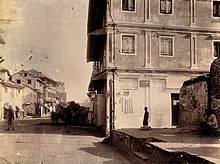Bombay plague epidemic
The Bombay plague epidemic was a bubonic plague epidemic that struck the city of Bombay (present-day Mumbai) in the late nineteenth century. The plague killed thousands, and many fled the city leading to a drastic fall in the population of the city.

Causes
The rapid growth of Bombay's commerce led to a large influx of workers. In the 1891 census the population of Bombay was counted to be 820,000. Most of the immigrant workers (over 70%) lived in chawls. The city services were not geared towards the well-being of the working class and various diseases were endemic to the slums.
Detection
In September 1896 the first case of bubonic plague was detected in Mandvi by Dr.Acacio Gabriel Viegas. It spread rapidly to other parts of the city, and the death toll was estimated at 1,900 people per week through the rest of the year. Many people fled from Bombay at this time, and in the census of 1901, the population had actually fallen to 780,000. Viegas correctly diagnosed the disease as bubonic plague and tended to patients at great personal risk. He then launched a vociferous campaign to clean up slums and exterminate rats, the carriers of the fleas which spread the plague bacterium. To confirm Viegas' findings, four teams of independent experts were brought in. With his diagnosis proving to be correct, the Governor of Bombay invited W M Haffkine, who had earlier formulated a vaccine for cholera, to do the same for the epidemic.[1]
In the first year of the plague, a research laboratory was set up at the JJ Hospital. It moved in 1899 to the Government House in Parel under the directorship of Haffkine. This was the beginning of the Haffkine Institute.
Those who could afford it tried to avoid the plague by moving out of the city. Jamsetji Tata tried to open up the northern suburbs to accommodate such people. The brunt of the plague was borne by mill workers. The anti-plague activities of the health department involved police searches, isolation of the sick, detention in camps of travellers and forced evacuation of residents in parts of the city. These measures were widely regarded as offensive and alarming. The extent of this outrage was demonstrated with the murder of W.C. Rand, British chairman of the Special Plague Committee. He was murdered by the Chapekar brothers, two Indian revolutionaries angered by the intrusive methods employed by the British to combat the plague in Pune.[2]
In 1900, the mortality rate from plague was about 22 per thousand. In the same year, the corresponding rates from tuberculosis were 12 per thousand, from cholera about 14 per thousand, and about 22 per thousand from various other illnesses classified as "fevers". The plague was fearsome only because it was apparently contagious. More mundane diseases took a larger toll.
On 9 December 1898 the Bombay City Improvement Trust was created by an act of the British Parliament. It was entrusted with the job of creating a healthier city. One of the measures taken by the CIT was the building of roads, like Princess Street and Sydenham Road (now Mohammedali Road), which would channel the sea air into the more crowded parts of the town.
References
- Hanhart, Joel (2016). Waldemar Mordekhaï Haffkine (1860-1930). Biographie intellectuelle. Paris: Éditions Honoré Champion.
- J., Echenberg, Myron (2007). Plague ports : the global urban impact of bubonic plague,1894-1901. New York: New York University Press. ISBN 978-0814722329. OCLC 70292105.